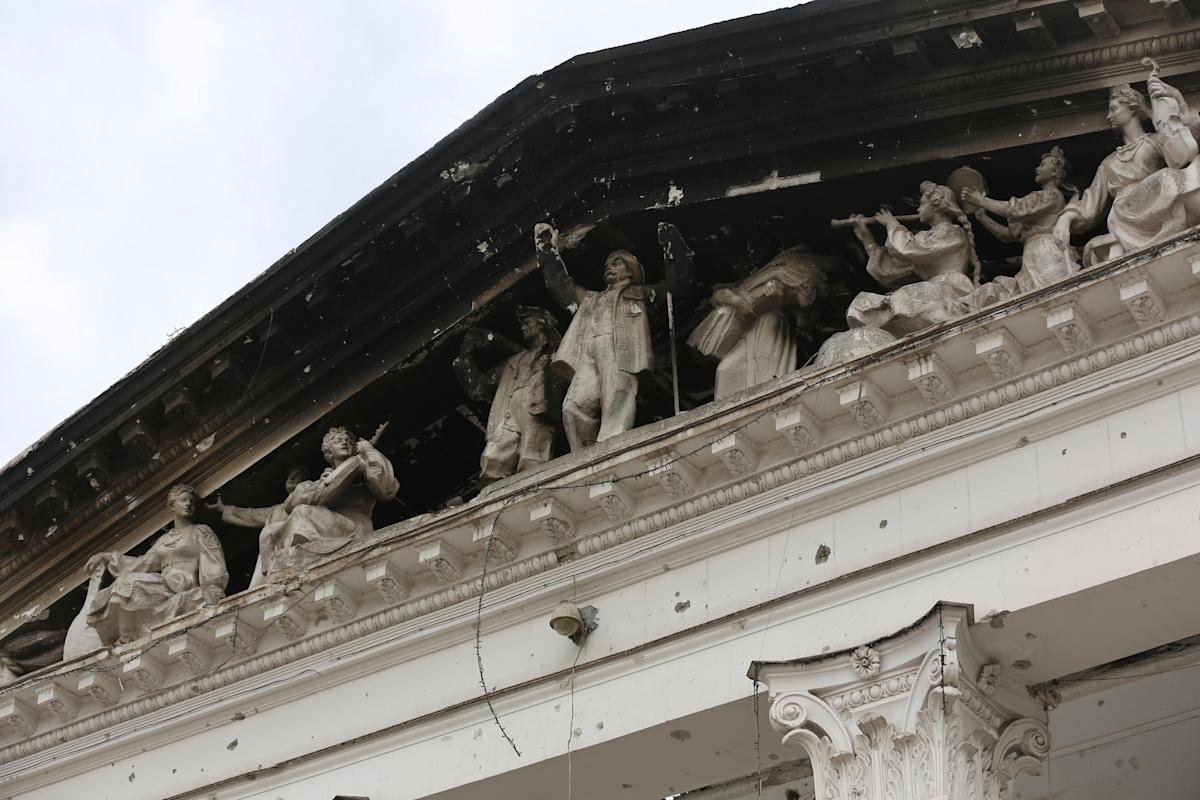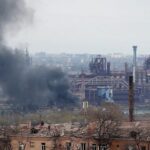
LVIV, Ukraine (AP) — She stood in just her bathrobe in the freezing basement of the Mariupol theater, coated in white plaster dust shaken loose by the explosion. Her husband tugged at her to leave and begged her to cover her eyes.
But she couldn’t help it — Oksana Syomina looked. And to this day, she wishes she hadn’t. Bodies were strewn everywhere, including those of children. Syomina had to step on the dead to escape the building that had served as the Ukrainian city’s main bomb shelter for more than a week.
Syomina, her husband and about 30 others ran blindly toward the sea and up the shore for almost five miles (eight kilometers) without stopping, the theater in ruins behind them.
“All the people are still under the rubble, because the rubble is still there,” Syomina said, weeping at the memory. “This is one big mass grave.”
Amid all the horrors that have unfolded in the war on Ukraine, the Russian bombing of the Donetsk Academic Regional Drama Theater in Mariupol on March 16 stands out as the single deadliest known attack against civilians to date. An Associated Press investigation has found evidence that the attack was in fact far deadlier than estimated, killing closer to 600 people inside and outside the building. That’s almost double the death toll cited so far.
The AP investigation recreated what happened inside the theater on that day from the accounts of 23 survivors, rescuers, and people intimately familiar with its new life as a bomb shelter. The AP also reconstructed a 3D model of the building based on witness accounts, two sets of floor plans of the theater, photos and video taken inside and feedback from experts who reviewed the methodology. With communications severed, people coming and going constantly, and memories blurred by trauma, an exact toll is impossible to determine.
The AP investigation refutes Russian claims that the theater was demolished by Ukrainian forces or served as a Ukrainian military base. None of the witnesses saw Ukrainian soldiers operating inside the building. And not one person doubted that the theater was destroyed in a Russian air attack aimed with precision at a civilian target with children in it.
The Russian siege of Mariupol started in the first days of March. The city soon ordered the entire theater opened as a bomb shelter, given its size, its unusually sturdy walls and its large basement.
About a week before the bombing, the theater’s set designer used white paint to inscribe the word “CHILDREN” in Cyrillic letters on the pavement outside, in the hope of staving off an attack from above. The signs, painted in both the front and back entrances, were large enough to be read even from satellites.
On March 9, a Russian airstrike hit a maternity hospital just a few blocks away, and two or three pregnant women moved to the theater for safety, according to two theater employees. The women, along with families with small children, were given the most comfortable dressing rooms on the second floor. It would turn out to be their doom.
By March 15, around 1,200 people crammed into the building, sleeping in offices, corridors, balconies, the basement. The theater became a place where anyone could get food and water supplied by the Red Cross or news about possible evacuations.
Among those who showed up in the hope of evacuating on the morning of March 16 were the Kutnyakov family and their neighbors.
“We were immediately offered and poured tea,” said Galina Kutnyakova, the 56-year-old matriarch. “You have to imagine, we had hardly eaten or drunk for six days. Everyone was so happy because of the hot tea.”
The basement was full already. So were the first and second floors. They saw a spot on the third floor, near enormous windows that everyone knew would surely shatter into knives of flying glass if the building was hit. It was the only place available, so they took it. It was around 10 a.m.
Maria Kutnyakova, Galina’s 30-year-old daughter, walked outside and heard a warplane. Then came the explosion.
She saw smoke rising from the enormous park with the theater at the center. The theater stood bare, with a huge chunk of its red roof on the ground. The meter (three-foot) thick walls by the field kitchen had disintegrated to dust.
As people fled the opposite way, Maria Kutnyakova ran into the hall looking for her mother and sister. Hoarse shouts for family members filled the air. At first she too shouted “Mom,” but she quickly realized that everyone around her was shouting the same word. So she screamed the family name instead.
Someone answered, “Masha Kutnyakova!” It sounded like it came from somewhere in the ground, but only the dead lay there.
She went to the stairs down to the basement and bomb shelter. There, at the bottom, stood her sister, covered in plaster dust, with a cat.
Their mother escaped out of a side exit. They made their way with a crowd of about 50 people to Mariupol’s Philharmonic, a nearby auditorium that also came under shelling at sunset.
“God, this is my cultural program for the day,” Maria Kutnyakova told herself bitterly.
The theater now lies in ruins, with its side and center blackened by fire. Russian forces control the neighborhood around it, and AP video shows heavy equipment swarming the rubble to further dismantle it. But the questions remain: How many bodies are there, and what happened to them?
Video taken by Russian state media shows no bodies inside. Some witnesses speculate that the bodies were either pulverized into the dust or removed by the Russians. With the site off-limits to investigators and the rubble itself taken away, witness testimony and photos and video of the theater before and after it was bombed will be crucial, said Clint Williamson, who served as U.S. ambassador-at-large for war crimes issues from 2006 to 2009.
The survivors from the theater attack remain haunted by their memories of what the Russians did.
“They came not to capture the city — they came to destroy it,” said Maria Kutnyakova, sitting in another auditorium in the city of Lviv. “They are trying to hide how many people actually died in Mariupol, hide their crimes.”
___
Beatrice Dupuy and Marshall Ritzel in New York, and Cara Anna in Lviv, contributed to the report.




